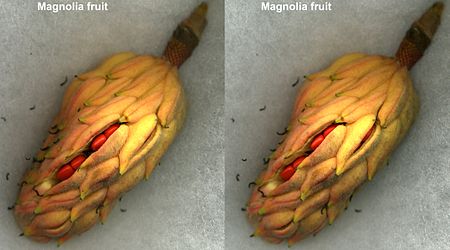| Magnolia Temporal range: Paleogene–Recent PreꞒ Ꞓ O S D C P T J K Pg N | |
|---|---|

| |
| Magnolia sieboldii | |
| Scientific classification | |
| Kingdom: | Plantae |
| Clade: | Tracheophytes |
| Clade: | Angiosperms |
| Clade: | Magnoliids |
| Order: | Magnoliales |
| Family: | Magnoliaceae |
| Genus: | Magnolia L. |
| Type species | |
| Magnolia virginiana L. | |
| Subgenera | |
| |
| Diversity | |
| 210 to 340 species | |
| Synonyms | |
List
| |
Magnolia is a large genus of about 210 to 340 flowering plant species in the subfamily Magnolioideae of the family Magnoliaceae. The natural range of Magnolia species is disjunct, with a main center in east, south and southeast Asia and a secondary center in eastern North America, Central America, the West Indies, and some species in South America.
Magnolia is an ancient genus. Fossilized specimens of M. acuminata have been found dating to 20 million years ago (mya), and fossils of plants identifiably belonging to the Magnoliaceae date to 95 mya. They are theorized to have evolved to encourage pollination by beetles as they existed prior to the evolution of bees. Another aspect of Magnolia considered to represent an ancestral state is that the flower bud is enclosed in a bract rather than in sepals; the perianth parts are undifferentiated and called tepals rather than distinct sepals and petals. Magnolia shares the tepal characteristic with several other flowering plants near the base of the flowering plant lineage, such as Amborella and Nymphaea (as well as with many more recently derived plants, such as Lilium).
The magnolia was made the state flower of Mississippi in 1900. The magnolia symbolizes stability in the United States; in China beauty and gentleness.
Description
| Stereo image | |||
|---|---|---|---|
| |||
| |||
| |||
| |||
| Mature magnolia fruit just starting to open, with a few seeds visible | |||
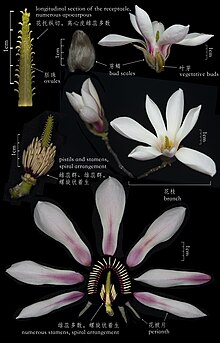

Magnolias are spreading evergreen or deciduous trees or shrubs characterised by large fragrant flowers, which may be bowl-shaped or star-shaped, in shades of white, pink, purple, green, or yellow. In deciduous species, the blooms often appear before the leaves in spring. Cone-like fruits are often produced in the autumn.
As with all Magnoliaceae, the perianth is undifferentiated, with 9–15 tepals in three or more whorls. The flowers are hermaphroditic, with numerous adnate carpels and stamens arranged in a spiral fashion on the elongated receptacle. The flowers' carpels are often damaged by pollinating beetles.
The fruit dehisces along the dorsal sutures of the carpels. The pollen is monocolpate, and the embryonic development is of the Polygonum type. Taxonomists, including James E. Dandy in 1927, have used differences in the fruits of Magnoliaceae as the basis for classification systems.

Taxonomy
History
Early
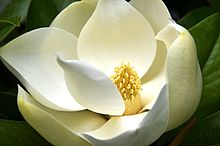


The name Magnolia first appeared in 1703 in the Genera written by French botanist Charles Plumier, for a flowering tree from the island of Martinique (talauma). It was named after French botanist Pierre Magnol. English botanist William Sherard, who studied botany in Paris under Joseph Pitton de Tournefort, a pupil of Magnol, was most probably the first after Plumier to adopt the genus name Magnolia. He was at least responsible for the taxonomic part of Johann Jacob Dillenius's Hortus Elthamensis and of Mark Catesby's Natural History of Carolina, Florida and the Bahama Islands. These were the first works after Plumier's Genera that used the name Magnolia, this time for some species of flowering trees from temperate North America. The species that Plumier originally named Magnolia was later described as Annona dodecapetala by Jean-Baptiste Lamarck and has since been named Magnolia plumieri and Talauma plumieri (among a number of other names), but is now known as Magnolia dodecapetala.
Carl Linnaeus, who was familiar with Plumier's Genera, adopted the genus name Magnolia in 1735 in his first edition of Systema Naturae, without a description but with a reference to Plumier's work. In 1753, he took up Plumier's Magnolia in the first edition of Species Plantarum. He described a monotypic genus, with the sole species being Magnolia virginiana. Since Linnaeus never saw a herbarium specimen (if there ever was one) of Plumier's Magnolia and had only his description and a rather poor picture at hand, he must have taken it for the same plant that was described by Mark Catesby in his 1730 Natural History of Carolina. He placed it in the synonymy of Magnolia virginiana var. fœtida, the taxon now known as Magnolia grandiflora. Under Magnolia virginiana, Linnaeus described five varieties (glauca, fœtida, grisea, tripetala, and acuminata). In the tenth edition of Systema Naturae (1759), he merged grisea with glauca and raised the four remaining varieties to species status.
By the end of the 18th century, botanists and plant hunters exploring Asia had begun to name and describe the Magnolia species from China and Japan. The first Asiatic species to be described by western botanists were Magnolia denudata, Magnolia liliiflora, Magnolia coco, and Magnolia figo. Soon after that, in 1794, Carl Peter Thunberg collected and described Magnolia obovata from Japan, and roughly at the same time Magnolia kobus was also first collected.
Recent
With the number of species increasing, the genus was divided into two subgenera, Magnolia and Yulania. Magnolia contains the American evergreen species M. grandiflora, which is of horticultural importance, especially in the southeastern United States, and M. virginiana, the type species. Yulania contains several deciduous Asiatic species, such as M. denudata and M. kobus, which have become horticulturally important in their own right and as parents in hybrids. Classified in Yulania is also the American deciduous M. acuminata (cucumber tree), which has recently attained greater status as the parent responsible for the yellow flower color in many new hybrids.
Relations in the family Magnoliaceae have puzzled taxonomists for a long time. Because the family is quite old and has survived many geological events (such as ice ages, mountain formation, and continental drift), its distribution has become scattered. Some species or groups of species have been isolated for a long time, while others could stay in close contact. To create divisions in the family (or even within the genus Magnolia) solely based upon morphological characters has proven to be a nearly impossible task.
By the end of the 20th century, DNA sequencing had become available as a method of large-scale research on phylogenetic relationships. Several studies, including studies on many species in the family Magnoliaceae, were carried out to investigate relationships. What these studies all revealed was that the genus Michelia and Magnolia subgenus Yulania were far more closely allied to each other than either one of them was to Magnolia subgenus Magnolia. These phylogenetic studies were supported by morphological data.
As nomenclature is supposed to reflect relationships, the situation with the species names in Michelia and Magnolia subgenus Yulania was undesirable. Taxonomically, three choices are available:
- to join Michelia and Yulania species in a common genus, not being Magnolia (for which the name Michelia has priority);
- to raise subgenus Yulania to generic rank, leaving Michelia names and subgenus Magnolia names untouched, or;
- to join Michelia with the genus Magnolia into the genus Magnolia s.l. (a big genus).
Magnolia subgenus Magnolia cannot be renamed because it contains M. virginiana, the type species of the genus and of the family.
Not many Michelia species have so far become horticulturally or economically important, apart from their wood. Both subgenus Magnolia and subgenus Yulania include species of major horticultural importance, and a change of name would be very undesirable for many people, especially in the horticultural branch. In Europe, Magnolia is even more or less a synonym for Yulania, since most of the cultivated species on this continent have Magnolia (Yulania) denudata as one of their parents. Most taxonomists who acknowledge close relations between Yulania and Michelia therefore support the third option and join Michelia with Magnolia.
The same goes, mutatis mutandis, for the (former) genera Talauma and Dugandiodendron, which are then placed in subgenus Magnolia, and genus Manglietia, which could be joined with subgenus Magnolia or may even earn the status of an extra subgenus. Elmerrillia seems to be closely related to Michelia and Yulania, in which case it will most likely be treated in the same way as Michelia is now. The precise nomenclatural status of small or monospecific genera like Kmeria, Parakmeria, Pachylarnax, Manglietiastrum, Aromadendron, Woonyoungia, Alcimandra, Paramichelia, and Tsoongiodendron remains uncertain. Taxonomists who merge Michelia into Magnolia tend to merge these small genera into Magnolia s.l. as well. Botanists do not agree on whether to recognize a big Magnolia or the different small genera. For example, Flora of China offers two choices: a large genus Magnolia, which includes about 300 species and everything in the Magnoliaceae except Liriodendron (tulip tree), or 16 different genera, some of them recently split out or re-recognized, each of which contains up to 50 species. The western co-author favors the big genus Magnolia, whereas the Chinese recognize the different small genera.
Fossil record
Fossils assignable to Magnolia extend into the Paleogene, such as Magnolia nanningensis, named for mummified wood from the Oligocene of Guangxi, China, which has a close affinity to members of the modern section Michelia.
Subdivision
See also: List of Magnolia speciesIn 2012, the Magnolia Society published on its website a classification of the genus produced by Richard B. Figlar, based on a 2004 classification by Figlar and Hans Peter Nooteboom. Species of Magnolia were listed under three subgenera, 12 sections, and 13 subsections. Subsequent molecular phylogenetic studies have led to some revisions of this system; for example, the subgenus Magnolia was found not to be monophyletic. A revised classification in 2020, based on a phylogenetic analysis of complete chloroplast genomes, abandoned subgenera and subsections, dividing Magnolia into 15 sections. The relationships among these sections are shown in the following cladogram, as is the paraphyletic status of subgenus Magnolia.
|
M. subg. Magnolia (not monophyletic) M. subg. Gynopodium M. subg. Yuliana |
The table below compares the 2012 and 2020 classifications. (The circumscriptions of the corresponding taxa may not be the same.)
| Figlar (2012) | Wang et al. (2020) | |
|---|---|---|
| Section | Subsection | Section |
| Talauma | Dugandiodendron | Splendentes |
| Cubenses | ||
| Talauma | Talauma | |
| Gwillimia | Gwillimia | Gwillimia |
| Blumiana | ||
| Auriculata | Tuliparia | |
| Macrophylla | Macrophylla | |
| Magnolia | Magnolia | |
| Rhytidospermum | Oyama | Oyama |
| Rhytidospermum | Rytidospermum | |
| Manglietia | Manglietia | |
| Kmeria | Kmeria | |
| Gynopodium | Gynopodium | |
| Manglietiastrum | ||
| Yulania | Yulania | Yulania |
| Tulipastrum | Tulipastrum | |
| Michelia | Maingola | Maingola |
| Aromadendron | ||
| Michelia | Michelia | |
| Elmerrillia | ||
Uses
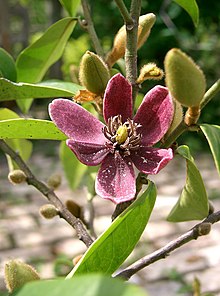


Horticulture
In general, the genus Magnolia has attracted horticultural interest. Some, such as the shrub M. stellata (star magnolia) and the tree M. × soulangeana (saucer magnolia) flower quite early in the spring, before the leaves open. Others flower in late spring or early summer, including M. virginiana (sweetbay magnolia) and M. grandiflora (southern magnolia). The shape of these flowers lend themselves to the common name tulip tree that is sometimes applied to some Magnolia species.
Hybridisation has been immensely successful in combining the best aspects of different species to give plants which flower at an earlier age than the parent species, as well as having more impressive flowers. One of the most popular garden magnolias, M. × soulangeana, is a hybrid of M. liliiflora and M. denudata. In the eastern United States, five native species are frequently in cultivation: M. acuminata (as a shade tree), M. grandiflora, M. virginiana, M. tripetala, and M. macrophylla. The last two species must be planted where high winds are not a frequent problem because of the large size of their leaves.
Culinary
The flowers of many species are considered edible. In parts of England, the petals of M. grandiflora are pickled and used as a spicy condiment. In some Asian cuisines, the buds are pickled and used to flavor rice and scent tea. In Japan, the young leaves and flower buds of M. hypoleuca are broiled and eaten as a vegetable. Older leaves are made into a powder and used as seasoning; dried, whole leaves are placed on a charcoal brazier and filled with miso, leeks, daikon, and shiitake, and broiled. There is a type of miso which is seasoned with magnolia, hoba miso.
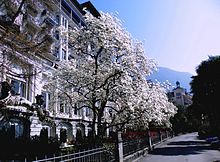


Traditional medicine
The bark and flower buds of M. officinalis have long been used in traditional Chinese medicine, where they are known as hou po (厚朴). In Japan, kōboku, M. obovata, has been used in a similar manner.
Timber
The cucumbertree, M. acuminata, grows to large size and is harvested as a timber tree in northeastern U.S. forests. Its wood is sold as "yellow poplar" along with that of the tuliptree, Liriodendron tulipifera. The Fraser magnolia, M. fraseri, also attains enough size sometimes to be harvested, as well.
Chemical compounds and bioeffects
The aromatic bark contains magnolol, honokiol, 4-O-methylhonokiol, and obovatol. Magnolol and honokiol activate the nuclear receptor peroxisome proliferator-activated receptor gamma.
Culture
Symbols
- White or Yulan magnolia (subgenus Yulania) is the official flower of Shanghai.
- Magnolia grandiflora is the state flower of both Mississippi and Louisiana. The flower's abundance in Mississippi is reflected in its nickname of "Magnolia State" and the state flag. The magnolia is also the state tree of Mississippi. One of the many nicknames for Houston is "Magnolia City". Historically, magnolias have been associated with the Southern United States.
- Magnolia sieboldii is the national flower of North Korea and the Gangnam District of Seoul.
Arts
- The 1989 movie Steel Magnolias is based on a 1987 play, Steel Magnolias, by Robert Harling. They are about the bond among a group of women from Louisiana, who can be as beautiful as magnolias, but are as tough as steel. The name 'magnolia' specifically refers to a magnolia tree about which they are arguing at the beginning.
- In the 1939 song "Strange Fruit", originally written as a poem by New York schoolteacher and communist activist Abel Meeropol to condemn the practice of lynching, the magnolia flower was referred to as being associated with the Southern United States, where many lynchings took place:
- Pastoral scene of the gallant south
- The bulging eyes and the twisted mouth
- Scent of magnolias, sweet and fresh,
- Then the sudden smell of burning flesh.
Despite Meeropol's frequent mention of the South and magnolia trees, the horrific image which inspired his poem, Lawrence Beitler's 1930 photograph of the lynching of Thomas Shipp and Abram Smith following the robbery and murder of Claude Deteer, was taken in Marion, Indiana, where magnolia trees are less common.
- In the 1960s, magnolias were a symbol of the South in the popular press: the New York Post noted of Lyndon Johnson that "A man who wore a ten-gallon Stetson and spoke with a magnolia accent had little hope of winning the Democratic nomination in 1960", and biographer Robert Caro picks up the symbol by saying that when Johnson became president "he taint of magnolias still remained to be scrubbed off."

See also
Notes
- The number of species in the genus Magnolia depends on the taxonomic view that one takes up. Recent molecular and morphological research shows that former genera Talauma, Dugandiodendron, Manglietia, Michelia, Elmerrillia, Kmeria, Parakmeria, Pachylarnax (and a small number of monospecific genera) all belong within the same genus, Magnolia s.l. (s.l. = sensu lato: 'in a broad sense', as opposed to s.s. = sensu stricto: 'in a narrow sense'). The genus Magnolia s.s. contains about 120 species. See the section Nomenclature and classification in this article.
- Under the rule of priority, the first name that is validly published in Linnaeus' Species Plantarum (1 May 1753) or any other work of any other botanist after that, takes precedence over later names. Plumier's name was not a binomen and moreover published before Species Plantarum, so it has no status. The first binomen published after 1753 was Lamarck's Annona dodecapetala (1786). Magnolia plumieri (1788) was published on a later date by Schwartz, and is treated as a later synonym, as are Magnolia fatiscens (1817; Richard), Talauma caerulea (Jaume St-Hilaire 1805) and Magnolia linguifolia (1822).
- Magnolia glauca has the same type specimen as Magnolia virginiana and as the latter is the first valid name, the species is now called Magnolia virginiana (sweetbay magnolia). Var. fœtida was renamed Magnolia grandiflora, which is legitimate as the epithet fœtida only has priority in its rank of variety. Magnolia grandiflora is the southern magnolia. Magnolia tripetala (umbrella magnolia) and Magnolia acuminata (cucumber tree) are still recognized as species.
- Under these names the species were described by Desrousseaux in Lamarck's Encyclopédie Méthodique Botanique, tome troisieme (1792): 675. In the beginning of the 20th century, descriptions which seemed to represent the same species, were found in a work of the French naturalist P.J. Buc'hoz, Plantes nouvellement découvertes (1779), under the names Lassonia heptapeta and Lassonia quinquepeta. In 1934, the English botanist J.E. Dandy argued that these names had priority over the names by which both species had been known for over a century and hence from then on Magnolia denudata had to be named Magnolia heptapeta, Magnolia liliiflora should be changed into Magnolia quinquepeta. After a lengthy debate, specialist taxonomists decided that the Buc'hoz's names were based on chimaeras (pictures constructed of elements of different species), and as Buc'hoz did not cite or preserve herbarium specimens, his names were ruled not to be acceptable.
- These species were published as Liriodendron coco and Liriodendron figo by J. de Loureiro in Flora Cochinchinensis (1790) and later (1817) transferred to Magnolia by A. P. de Candolle. Magnolia figo was soon after transferred to the genus Michelia.
- In 1927 J.E. Dandy accepted 10 genera in The genera of Magnoliaceae, Kew Bulletin 1927: 257–264. In 1984 Law Yuh-Wu proposed 15 in A preliminary study on the taxonomy of the family Magnoliaceae, Acta Phytotaxonomica Sinica 22: 89–109; in 2004 even 16, in Magnolias of China. This is not just about grouping some genera together where others do not; authors often choose different boundaries.
- "Tulip tree" usually refers to Liriodendron tulipifera, but sometimes refers to Magnolia species, especially Magnolia × soulangeana.
References
- "Magnolia Plum. ex L." Plants of the World Online. Royal Botanic Gardens, Kew. Retrieved 2022-03-25.
- Crane, P.R. (1988). "The phylogenetic position and fossil history of the Magnoliaceae". In Hunt, David R. (ed.). Magnolias and their allies: Proceedings of an International Symposium, Royal Holloway, University of London, Egham, Surrey, U.K., 12-13 April 1996. Milbourne Port. p. 21. ISBN 978-0-9517234-8-7. OCLC 40781614.
{{cite book}}: CS1 maint: location missing publisher (link) - Peigler, Richard (1988). "A review of pollination of Magnolias by beetles, with a collecting survey made in the Carolinas" (PDF). Magnolia. 24 (45): 1–7. Archived (PDF) from the original on 2022-10-09.
- Brickell, Christopher (2008). The Royal Horticultural Society A-Z encyclopedia of garden plants (3rd ed.). United Kingdom: Dorling Kindersley. p. 661. ISBN 978-1-4053-3296-5.
- Bernhardt, P. (2000). "Convergent evolution and adaptive radiation of beetle-pollinated angiosperms" (PDF). Plant Systematics and Evolution. 222 (1–4): 293–320. Bibcode:2000PSyEv.222..293B. doi:10.1007/bf00984108. S2CID 25387251. Archived from the original (PDF) on 2015-12-23.
- Richard B. Figlar. "Those Amazing Magnolia Fruits" (PDF). Magnoliasociety.org. Archived (PDF) from the original on 2022-10-09. Retrieved 2022-03-12.
- Plumier, C. (1703) Nova plantarum Americanarum genera. Paris. .
- Dillenius, J.J. (1732), Hortus Elthamensis, seu plantarum rariorum quas in horto suo Elthami in Cantio coluit vir ornamentissimus et praestantissimus Jacobus Sherard. London .
- Catesby, M. (1730), The Natural History of Carolina, Florida and the Bahama Islands, containing the figures of birds, beasts, fishes, serpents, insects and plants, Vol. 1. London.
- Lamarck, J.B.P.A. de (1786), Encyclopédie Méthodique Botanique, tome second: 127. Paris.
- Magnolia kobus only received its name in 1814, when it was validly published by A.P. de Candolle. There has been much confusion about earlier attempts to validly publish this species, especially because descriptions and type specimens did not match.
- Azuma, H.; Thien, L.B.; Kawano, S. (1999). "Molecular phylogeny of Magnolia (Magnoliaceae) inferred from cpDNA sequences and evolutionary divergence of the floral scents". Journal of Plant Research. 112 (1107): 291–306. Bibcode:1999JPlR..112..291A. doi:10.1007/pl00013885. S2CID 206862607.
- Azuma, H.; García-Franco, J.G.; Rico-Gray, V.; Thien, L.B. (2001). "Molecular phylogeny of the Magnoliaceae: the biogeography of tropical and temperate disjunctions". American Journal of Botany. 88 (12): 2275–2285. doi:10.2307/3558389. JSTOR 3558389. PMID 21669660.
- Kim, S.; et al. (2001). "Phylogenetic relationships in family Magnoliaceae inferred from ndhF sequences". American Journal of Botany. 88 (4): 717–728. doi:10.2307/2657073. JSTOR 2657073. PMID 11302859.
- Figlar, R.B. (2000), Proleptic branch initiation in Michelia and Magnolia subgenus Yulania provides basis for combinations in subfamily Magnolioideae. In: Liu Yu-hu et al., Proceedings of the International Symposium on the Family Magnoliaceae: 14–25, Science Press, Beijing.
- 4. Magnoliaceae, Flora of China
- Huang, Lu-Liang; Jin, Jian-Hua; Quan, Cheng; Oskolski, Alexei A. (January 2020). "Mummified Magnoliaceae woods from the upper Oligocene of South China, with biogeography, paleoecology, and wood trait evolution implications". Journal of Systematics and Evolution. 58 (1): 89–100. doi:10.1111/jse.12480. ISSN 1674-4918. S2CID 91861708.
- ^ Figlar, Richard B. (April 2012). "Magnolia Classification". Magnolia Society International. Archived from the original on 12 March 2022. Retrieved 27 May 2020.
- Figlar, R.B. & Nooteboom, H.P. (2004), "Notes on Magnoliaceae IV", Blumea, 49: 87–100, doi:10.3767/000651904X486214
- ^ Wang, Y.-B.; Liu, B.-B.; Nie, Z.-L.; Chen, H.-F.; Chen, F.-J.; Figlar, R.B. & Wen, J. (2020), "Major clades and a revised classification of Magnolia and Magnoliaceae based on whole plastid genome sequences via genome skimming", Journal of Systematics and Evolution, 58 (5): 673–695, doi:10.1111/jse.12588, S2CID 216340359
- William Miller. "Magnolia." A Dictionary of English Names of Plants: Applied in England and Among English-speaking People to Cultivated and Wild Plants, Trees, and Shrubs. John Murray, 1884. p. 217.
- Richard Brook. New Cyclopædia of Botany and Complete Book of Herbs: Forming a History and Description of All Plants, British Or Foreign (etc.). W. M. Clark, 1854. p. 248.
- Roger Holmes. Taylor's Master Guide to Gardening. Houghton Mifflin, 1994. ISBN 9780618159079 p. 118.
- Pat Munts and Susan Mulvihill. Northwest Gardener's Handbook: Your Complete Guide: Select, Plan, Plant, Maintain, Problem-Solve: Oregon, Washington, Northern California, British Columbia. Cool Springs Press, 2015. ISBN 9781627885522 p. 209.
- Amy Renea. Crafting with Nature: Grow or Gather Your Own Supplies for Simple Handmade Crafts, Gifts & Recipes. Page Street, 2016. ISBN 9781624142055 p. 173.
- Facciola, S. (1990). A Source Book of Edible Plants. Cornucopia. Vol. I. Kampong Publications. ISBN 0-9628087-0-9.
- Facciola, S. (1998). A Source Book of Edible Plants. Cornucopia. Vol. II. Kampong Publications. ISBN 0-9628087-2-5.
- "Magnolia Flower (xin yi hua)". www.acupuncturetoday.com. 2019-02-01. Retrieved 2021-09-04.
- Poivre, Mélanie; Duez, Pierre (March 2017). "Biological activity and toxicity of the Chinese herb Magnolia officinalis Rehder & E. Wilson (Houpo) and its constituents". Journal of Zhejiang University. Science. B. 18 (3): 194–214. doi:10.1631/jzus.B1600299. ISSN 1673-1581. PMC 5365644. PMID 28271656.
- Han, H.; Jung, J.K.; Han, S.B.; Nam, S.Y.; Oh, K.W.; Hong, J.T. (2011). "Anxiolytic-like effects of 4-O-methylhonokiol isolated from magnolia officinalis through enhancement of GABAergic transmission and chloride influx". Journal of Medicinal Food. 14 (7–8): 724–731. doi:10.1089/jmf.2010.1111. PMID 21501091.
- Kalman, D.S.; Feldman, S.; Feldman, R.; Schwartz, H.I.; Krieger, D.R.; Garrison, R. (2008). "Effect of a proprietary Magnolia and Phellodendron extract on stress levels in healthy women: A pilot, double-blind, placebo-controlled clinical trial". Nutrition Journal. 7 (1): 11. doi:10.1186/1475-2891-7-11. PMC 2359758. PMID 18426577.
- Ma, L.; Chen, J.; Wang, X.; Liang, X.; Luo, Y.; Zhu, W.; Wang, T.; Peng, M.; Li, S.; Jie, S.; Peng, A.; Wei, Y.; Chen, L. (2011). "Structural modification of honokiol, a biphenyl occurring in magnolia officinalis: The evaluation of honokiol analogues as inhibitors of angiogenesis and for their cytotoxicity and structure-activity relationship". Journal of Medicinal Chemistry. 54 (19): 6469–6481. doi:10.1021/jm200830u. PMID 21853991.
- Fried, L.E.; Arbiser, J.L. (2009). "Honokiol, a multifunctional antiangiogenic and antitumor agent". Antioxidants & Redox Signaling. 11 (5): 1139–1148. doi:10.1089/ars.2009.2440. PMC 2842137. PMID 19203212.
- Hu J.; Chen L.-J.; Liu L.; Chen X.; Chen P.; Yang G.-L.; Hou W.-L.; Tang M.-H.; Zhang F.; Wang X.-H.; Zhao X.; Wei Y.-Q. (2008). "Liposomal honokiol, a potent anti-angiogenesis agent, in combination with radiotherapy produces a synergistic antitumor efficacy without increasing toxicity". Experimental & Molecular Medicine. 40 (6): 617–628. doi:10.3858/emm.2008.40.6.617. PMC 2679338. PMID 19116447.
- Lee YJ, Lee YM, Lee CK, Jung JK, Han SB, Hong JT (2011). "Therapeutic applications of compounds in the Magnolia family". Pharmacol. Ther. 130 (2): 157–176. doi:10.1016/j.pharmthera.2011.01.010. PMID 21277893.
- Fakhrudin, N.; Ladurner, A.; Atanasov, A.G.; Heiss, E.H.; Baumgartner, L.; Markt, P.; Schuster, D.; Ellmerer, E.P.; Wolber, G.; Rollinger, J.M.; Stuppner, H.; Dirsch, V.M. (Apr 2010). "Computer-aided discovery, validation, and mechanistic characterization of novel neolignan activators of peroxisome proliferator-activated receptor gamma". Mol. Pharmacol. 77 (4): 559–66. doi:10.1124/mol.109.062141. PMC 3523390. PMID 20064974.
- Atanasov AG, Wang JN, Gu SP, Bu J, Kramer MP, Baumgartner L, Fakhrudin N, Ladurner A, Malainer C, Vuorinen A, Noha SM, Schwaiger S, Rollinger JM, Schuster D, Stuppner H, Dirsch VM, Heiss EH (October 2013). "Honokiol: A non-adipogenic PPARγ agonist from nature". Biochimica et Biophysica Acta (BBA) - General Subjects. 1830 (10): 4813–4819. doi:10.1016/j.bbagen.2013.06.021. PMC 3790966. PMID 23811337.
- Scanlon, J. (2007). "If my husband calls I'm not here: The beauty parlor as real and representational female space". Feminist Studies. 33: 2.
- Caro, Robert A. (2012). The Passage of Power. The Years of Lyndon Johnson. Vol. 4. New York: Alfred A. Knopf. p. 348.
- Maloney, Sarah. "Sarah Maloney".
- Maloney, Sarah (2014). "Sarah Maloney: First Flowers". Archived from the original on 2015-09-24. Retrieved 2015-02-19.
Bibliography
- Johnstone, G.H. (1955). Asiatic Magnolias in cultivation. London: The Royal Horticultural Society.
- Kapil, R. N.; Bhandari, N. N. (1964). "Morphology and embryology of Magnolia Dill. ex Linn" (PDF). Proceedings of the National Academy of Sciences, India. 30: 245–262. Archived from the original (PDF) on 1 May 2013.
- Callaway, D.J. (1994). The World of Magnolias. Portland, OR: Timber Press. ISBN 0-88192-236-6.
- Hunt, D., ed. (1998). Magnolias and their Allies. International Dendrology Society & Magnolia Society. ISBN 0-9517234-8-0.
- Law, Y.W. (= Liu, Y.H.) (2004). Magnolias of China. Hong-Kong: Beijing Science & Technology Press. ISBN 7-5304-2765-2.
{{cite book}}: CS1 maint: multiple names: authors list (link) - Thien, Leonard B. (November–December 1974). "Floral biology of Magnolia". American Journal of Botany. 61 (10): 1037–1045. doi:10.1002/j.1537-2197.1974.tb12321.x. JSTOR 2441921.
- Treseder, N.G. (1978). Magnolias. London; Boston, MA: Faber & Faber. ISBN 0-571-09619-0.
- Cicuzza, D.; Newton, A.; Oldfield, S. (2007). The Red List of Magnoliaceae (PDF). Fauna & Flora International and Botanic Gardens (Report). Conservation International. Archived (PDF) from the original on 2022-10-09.
- Xu, F.; Rudall, P. J. (April 2006). "Comparative floral anatomy and ontogeny in Magnoliaceae". Plant Systematics and Evolution. 258 (1–2): 1–15. Bibcode:2006PSyEv.258....1X. doi:10.1007/s00606-005-0361-1. S2CID 26125303.
External links
- Magnolia images at the Arnold Arboretum of Harvard University Plant Image Database
- Friedman, William (Ned). "Hunting magnolia fruits at the Arboretum." Posts from the Collection, Arnold Arboretum of Harvard University website, 20 October 2019. Accessed 29 April 2020.
- Dosmann, Michael and Nancy Rose. "Early to Evolve, Early to Flower: Collections Up Close Spotlights the Magnolia Collection." Arnold Arboretum of Harvard University website, Spring/Summer 2014. Accessed 29 April 2020.
- "Magnolia - April Tree of the Month." Arnold Arboretum of Harvard University, 2014. Accessed 29 April 2020.
- Glasser, Larissa. "Magnolia madness in April." Blog of the Arnold Arboretum Horticultural Library, Arnold Arboretum of Harvard University website, 19 April 2017. Accessed 29 April 2020.
- "NCCPG National Magnolia Collection". Caerhays Castle Garden (UK).
- "Conserving threatened Magnolia species". Botanic Gardens Conservation International (BGCI). Archived from the original on 2016-03-10. Retrieved 2011-04-01.
Background information, reports, images and related articles
- "Magnolia Society".
- "Magnolias Threatened by Logging, Development". NPR.org. National Public Radio.
- "Magnolia Trees". Extension. Selecting Trees for your Home. University of Illinois.
- "Magnolia" . Encyclopædia Britannica (11th ed.). 1911.
| Taxon identifiers | |
|---|---|
| Magnolia |
|
